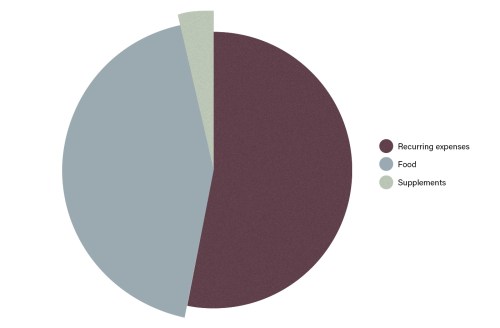How a 51-Year-Old Social Worker Is Saving for Her Golden Years With the Help of a Side Hustle
See what financial planning in 50s looks like for a married semi-retired social worker, who has a side-hustle that brings in passive income.

You know where your friends get their hair done, what their dream job is, and even the details of the most recent fight they had with their partner. But what about their salary? Or how much they spend on athleisure every month? For some reason, talking about money remains taboo for many.
That’s where Well+Good’s Checks+Balanced series comes in. Think of it as a space to inspire more open and frank conversations around money—especially regarding how different people are able to afford the wellness habits that are important to them.
Here, Sallie, a 51-year-old social worker living in Georgia shares her spending habits and how she and her husband are planning for their golden years.
Keep reading to see how Sallie prioritizes her healthy habits while planning for her golden years.

Sallie, 51, part-time social worker, St. Marys, Georgia
Income: $60,000 per year. I’m a licensed social worker, and I transitioned to working part-time back in May 2019. I bring in $60,000 from that job. My husband is retired military and he also now works part-time as a stocker at a grocery store. He brings in $40,000 annually from that job.
We also have two rental properties that generate passive income outside our part-time jobs. After accounting for the expenses associated with maintaining the properties, the rentals bring in additional $1,200 a month. Retirement is definitely a component of aging that my husband and I both have long been planning for—and continue to plan for. We always knew we would have my husband’s retirement money from the military, and I have also contributed to a 401(k) while working. (My husband has a 401(k) plan as well.) The rental properties also provide us some good extra money.
Mortgage: $0. We own our home, so we don’t have a monthly mortgage payment.
Other recurring expenses: $590 per month. My husband and I own both our cars, so we don’t have monthly car payments. We do, though, pay $300 a month for car and home insurance. Other than that, our only recurring expenses are our utilities bill, phone bill ($150 per month), and Internet and cable ($140 per month).
Food: $120 a week. I’m definitely health-conscious and try to include vegetables at every meal, and my husband and I eat meat for our proteins. Because he’s retired military, we’re able to do our food shopping at the commissary, where everything is really well-priced because the commissary isn’t a for-profit business. They have anything you could want, and if they don’t have something you want, they’ll order it for you. I would say I spend about $80 a week on groceries. I also have a vegetable garden, so I grow a lot of the produce we eat, like broccoli, cabbage, onions, sweet potatoes, and kale. We live right on the Georgia-Florida border, so the weather is nice enough to grow vegetables 10 months of the year.
Before the pandemic, every Tuesday we would meet up with a group of friends for dinner as a way to try more places and socialize, but, of course, that has been put on hold for now. Because we’re not eating out once a week, we spend slightly more on groceries than before the pandemic, although incorporating the vegetables from the garden into our meals has definitely help cut costs without compromising healthy food choices.
Fitness: $0. Gardening is one of the main ways I stay active. I also like to go on walks.
Beauty: $520 per year. I get my hair cut every six weeks, and each visit costs $40. My salon was closed due to COVID-19 from March until mid-June, but since it’s back open now, I’m back to going every six weeks. Other than that, wear the bare minimum when it comes to makeup (largely because I’m allergic to a lot of products), so I probably only spend about $20 a month on beauty products. I use aloe vera gel for my facial moisturizer, and my makeup brands of choice are BareMinerals and Physicians Formula.
Supplements: $40 per month. I take several supplements every day, including fish oil, calcium, and a glucosamine chondroitin complex (which might be beneficial for joint health) because I have arthritis that runs in my family. I do what I can to keep my joints as healthy as possible. I spend about $40 a month on supplements.
Future planning: I have a savings account that serves as both an emergency fund and a travel fund, which we’ll use when it’s safe to travel again. Any money I have leftover at the end of the month, I contribute to this savings.
We have three adult kids, and one lives in another state, so we travel to visit him a few times a year. My husband and I also try to take one big international trip every few years. We were planning a big trip to Scotland before the pandemic, but, of course, that has now been put on hold. We did visit with family during the dates we were originally planning on being in Scotland. And we spent our time at an Airbnb property for that mini-trip to avoid crowds.
We plan to get our overseas travels completed while we are still young and active enough to be able to hike and go on long-term trips. Once we get older, we plan on doing most of the travel within the continental U.S., with shorter spurts—which will also be less expensive and help us to not deplete our savings. We definitely plan on being as active as possible.
Self care:$0. Self care is important to me. I am involved with my local church and also do my best to practice general mindfulness, gratitude, and being present. I also crochet, which I love because you see your progress right away. It’s something that, on a bad day, can provide a simple joy.
Want to learn more about how you can plan for the future emotionally and logistically—as well as financially? Head to Fidelity for the expert intel.
If you want to be featured in Checks+Balanced, email [email protected]. And if you want to take a page out of Sallie’s book and prioritize self-care more, here are 22 ideas.
Sponsored by Fidelity
Fidelity Brokerage Services LLC, Member NYSE, SIPC
Sign Up for Our Daily Newsletter
Get all the latest in wellness, trends, food, fitness, beauty, and more delivered right to your inbox.
Got it, you've been added to our email list.








